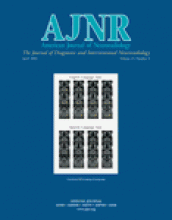Abstract
BACKGROUND AND PURPOSE: Endovascular detachable coil is being increasingly used for the treatment of cerebral aneurysms but little information is available about its feasibility and effectiveness in people. We assessed clinical outcomes in elderly patients with ruptured intracranial aneurysms treated with selective embolization.
METHODS: Between 1996 and 2002, 68 patients aged 65–80 years (mean age, 71 years) were treated by selective embolization with coils. Among them, 34 had a Hunt and Hess (HH) grade of I or II; 15, an HH grade of III; and 19, an HH grade of IV or V. All patients except four were treated within 72 hours after initial bleeding; those four patients had an HH grade of IV or V and were treated at 3–6 weeks after their clinical recovery. Clinical outcomes were assessed by using the Modified Glasgow Outcome Scale. Mean duration of follow-up was 20 months (range, 6–36 months).
RESULTS: Endovascular treatment resulted in 47 complete occlusions (69%), 15 neck remnants (22%), and six incomplete occlusions (9%). Procedural complications occurred in eight patients (12%). Outcomes were good or excellent in 40 patients (59%), including the four treated 3–6 weeks after initial bleeding. A fair or poor outcome was observed in 14 patients (20.5%), including two with an HH grade of I or II. Of 14 patients (20.5%) who died, 13 (93%) had an HH grade of IV or V. No rebleeding occurred during follow-up.
CONCLUSION: Endosaccular coiling may be proposed in elderly people with ruptured intracranial aneurysms. However, in patients with HH grade IV or V lesions, morbidity and mortality rates remain high, and embolization should be considered only after their clinical recovery.
- Copyright © American Society of Neuroradiology












